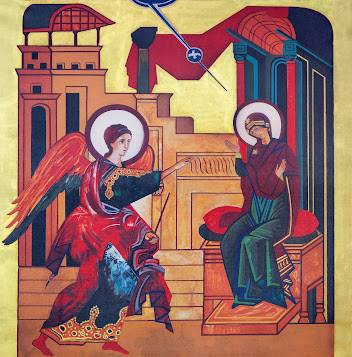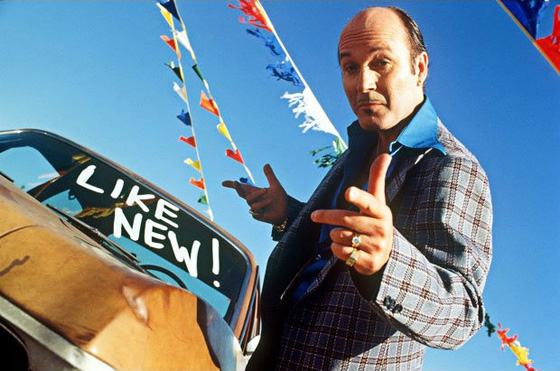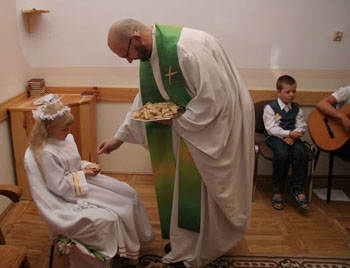Here now at the midway point of our 9-part look at Graham Moorhouse's excellent analysis of the Neocatechumenal Way, we examine five well-rehearsed "sales tricks" employed by the Way and its apologists to help sell their liturgical shenanigans and soften the everyman to accept them. Before we look at each one in turn, let's get the quick rundown:
- Promote the post-conciliar myth of the DIY liturgies of the early Christians.
- Just lie about Vatican II; after all, everyone else does. Most people won't have read the documents anyway, so you can say what you like and get away with it.
- Distort history.
- Mock the traditional liturgy of the Church.
- Employ a mental sleight of hand/false choice. [I rephrased this last one, as Moorhouse's title for it was repetitive and doesn't give you a good preview of what's to come.]
For #1, Moorhouse recounts a widely circulated (and thus widely believed) myth that the Mass of the early Church was
an unstructured spontaneous event, a festive meal which took place round the kitchen table with everyone encouraged to chip in their two penny worth, somewhat like a special birthday party with Jesus as an important guest. (Cult Fiction, p. 10)
"According to this fabrication," he goes on to say, "the formalized liturgies of the Church were written centuries later."
To illustrate how ridiculous this is, Moorhouse recounts a story from Rosalind Moss (now Mother Miriam), who, upon attending her first Catholic Mass after being raised Jewish, commented that it reminded her more of a synagogue service. [You can listen to more of Mother's story here.] Moorhouse then asks:
Are we really supposed to believe that the early Church had no formal liturgy, it was just partying spontaneously in the Spirit, and many centuries later when the Church got around to writing formal liturgies, the Church just happened by sheer chance to write liturgies so similar to those of our Jewish forefathers in faith that two thousand years later a young Jewess, coming out of a Catholic church in the USA, could exclaim... "it was a synagogue service!" (Cult Fiction, p. 10)
A reasonable person should surely be incredulous at such a claim. For further instructional reading, we recommend Scott Hahn's The Lamb's Supper (as well as The Fourth Cup); Brant Pitre's Jesus and the Jewish Roots of the Eucharist; and Edward Sri's A Biblical Walk Through the Mass.
Moorhouse concludes by commenting that despite the Way's apparent love for Scripture, they conveniently ignore much of the contents of the Book of Revelation, which contains:
robed priests, congregations chanting "holy holy holy," virgins, candlesticks, the smoke of incense, the invocation of angels and saints, heavenly choirs, musical instruments... and a lamb, a lamb slain on an altar, on an altar please note. (Cult Fiction, p. 10)
Is it more likely, asks Moorhouse, that St. John was having visions of liturgies centuries in the future which contained these elements, or was he instead alluding to contemporary liturgies with which his readers would have had at least a degree of familiarity?
Yeah, I think so, too.
One of the biggest lies that the Way propagates (and they are far from the only ones) is that Vatican II ushered in a new Mass. In actual fact, says Moorhouse:
Vatican II mandated that Latin Rite Catholics should retain Latin as the language of their liturgy and that the faithful should be taught the Latin responses; it further mandated that Gregorian chant should remain the music of the Church. (Cult Fiction, p. 10)
Indeed, that can all be found in the Council's Constitution on Sacred Liturgy, Sacrosanctum Concilium. For instance:
Particular law remaining in force, the use of the Latin language is to be preserved in the Latin rites...
In Masses which are celebrated with the people, a suitable place may be allotted to their mother tongue... Nevertheless steps should be taken so that the faithful may also be able to say or to sing together in Latin those parts of the Ordinary of the Mass which pertain to them. (SC 36; 54.)
and:
The treasure of sacred music is to be preserved and fostered with great care...
The Church acknowledges Gregorian chant as specially suited to the Roman liturgy: therefore, other things being equal, it should be given pride of place in liturgical services. (SC 114; 116)
Let's take these short excerpts from one of Vatican II's cornerstone documents and compare it to this excerpt from the Way's Catechetical Guide:
The answer to this situation of the Church has been the Second Vatican Council. In the face of these processes of desacralization, dechristianization and crisis of faith, the Holy Spirit did not remain indifferent but replied with the Council...
But now comes the most important thing: how to bring what the Council has done to the parish? How to apply the renewal of the Council to the concrete parish? By means of a neocatechumenal Christian community, by opening a neocatechumenal way. (p. 61)
Got that? The Holy Spirit, essentially asleep and indifferent since the 4th century, decided the crisis in the Church was too much and He couldn't remain indifferent any longer, so He woke up and gave the Church Vatican II. And more important than that, the Church needed a Way to practically apply Vatican II, so the Holy Spirit gave the Church Kiko and the Neocatechumenal Way. The Way is the Holy Spirit's specially chosen pratical application of the Council. But tell me, when do Neocatechumenal communities respond in Latin during their Eucharistic celebrations? Which music has pride of place in the Way - Gregorian chant, or Kikian compositions?
Moorhouse's other main point in this section is to point out that the Eastern rites of the Church did not tinker with their liturgies to nearly the fundamental degree that the Latin rite did after Vatican II. As noted scholar Peter Kwasniewski points out in this article about the Maronite rite, this is true to a degree, but not entirely accurate.
Moorhouse also connects this point to a note that Sacrosanctum Concilium even had for one of its "principal experts" (or periti) an Eastern Catholic, further indicating the "traditional" mindset behind the document's authorship. The Eastern Catholic so named is Abbot Boniface. Here is an excerpt from a 2002 interview with Abbot Boniface - you may decide for yourself if the abbot probably agrees more with Moorhouse or the "Spirit of the Council" crowd.
The third trick, "distort history," involves the lie that the Church has been shrinking since World War II. In fact, Moorhouse says, the Church (specifically in Britain, where he lives) was growing rapidly after World War II, and didn't begin its implosion until after Vatican II - "just when," Moorhouse says, "many of the liturgical novelties so favored by the Way began to be foisted upon us."
Moorhouse provides a data chart on page 11, which we will refer you to look at for yourself. In this chart, he shows that between 1945 (the end of the War) and 1965 (the end of the Council), Mass attendance in Britain increased 78%, and baptisms increased a staggering 95%. Between 1945 and 1967, when the Novus Ordo was promulgated, the number of British priests increased 26%. Then, when looking at the years between 1965 and 2002, Mass attendance fell by 57%, baptisms fell by 53%, and priestly vocations fell by 22%. He does not provide a source for any of these numbers, merely stating that the information has been "extrapolated from secondary data." However, we on this very blog site have run our own numbers for similar data sets (though not reaching that far back into the past) and arrived at similar conclusions - namely, that the Neocatechumenal Way does not reverse the Catholic exodus one iota.
The fourth tactic is to mock the Church's traditional liturgy.
Rubbish the Church's traditional liturgy by saying things like, "In the past priests stood in the corner muttering incoherently with their backs to the people." This vision should be reinforced by a bit of absurd miming. Such ignorant caricatures...ought to be offensive to all right-minded Catholics. (Cult Fiction, p. 11)
I cannot speak to how priests in decades or centuries past may have celebrated Holy Mass. Undoubtedly priests would sometimes get lazy and complacent and simply and robotically "go through the motions" of saying Mass - and priests today can be just as guilty of this (and if you're one of those who already has issues with the Novus Ordo, just wait until you get a lazy Novus Ordo). However, to mock traditional liturgy as a whole simply because the priest faced ad orientem or because there are certain parts of the traditional Mass that are said inaudibly is indeed the height of ignorance.
I've heard some terrible homilies in my day. I still get a good laugh (and a good cringe) remembering the priest who, in a desperate attempt to sound "with it" modernized Jesus' words to Peter in the garden to be "Come on, just hang out and chill with me for a while." (I think even the insipid Message Bible does better than that). But only once has a homily made me so angry and agitated that I seriously contemplated getting up and walking out.
That happened on a Holy Thursday one year, when my old Neocat pastor proclaimed loudly and confidently (the only way he knows how) that the faithful were simply not allowed to participate in Mass before Vatican II. Imagine! St. Catherine of Siena was never allowed to be a lector, so she couldn't participate at Mass. St. Thomas More could never be an extraordinary minister of Holy Communion, so his participation at Mass was stunted. Pope St. Pius X said parts of his Papal High Masses inaudibly, and he never faced his massive congregations at St. Peter's Basilica, so he was preventing them from participating. St. Thérèse never got to give her own mini homilies or belt "He Rose From Death" at the top of her lungs, so she was deprived of genuine Mass participation.
Just this past Sunday I attended a Latin Mass, and do you know what the homily was about? How the faithful can more deeply and reverently participate in the sacrifice of the Mass. Spoiler alert: the priest did not say "Ha ha, you can't. Too bad, so sad. Now let me and the altar servers unintelligibly recite the Creed because we're better than you."
Consider even my family's regular Novus Ordo parish: the Masses are ad orientem. The Mass parts are chanted in Latin. There are (almost) never extraordinary ministers of Holy Communion. There is a communion rail that, while optional, is still widely used by communicants. Many women freely choose to wear veils. I mean, honestly, how backward can you get?? But somehow we parishioners still manage to feel engaged and connected to our Blessed Lord every single Sunday.
Moorhouse concludes with an amusing exercise in imagination:
As for following Christ, Christ's lingua franca was Aramaic, but in the temple he worshipped in Hebrew, as his fellow Jews do to this very day. I have often mischievously wondered whether Our Blessed Lord received snide asides after the last supper about "mumbling in a foreign language" from his Aramaic speaking apostles. (Cult Fiction, p. 12)
While so much more could (and should) be said on the Church's lost patrimony of traditional disciplines, I leave you with this short article from Catholic Answers about the Latin language, and a recommendation to read this excellent book by Fr. Uwe Michael Lang about the direction of liturgical prayer.
Moorhouse describes the final technique, that of a "false choice" or a "mental sleight of hand," this way:
The human mind is so constructed that presented with two choices, it will accept the lesser evil or more good. Thus a salesman will say to you, "May I see you at 2 o'clock or 5 o'clock?" Your mind thinks, "I have to pick the children up at 5 o'clock, so I'll make it 2 o'clock." Only a minority spot the fact that the real choice they had, i.e. to see him or not to see him, had been removed by this sleight of hand...
Now let's observe the sleight of hand used to make [the Way's proposition] acceptable. First we are presented, with the aid of a little drawing [see p. 48 of the Catechetical Guide], of a pre-Christian pagan offering sacrifices on an altar to appease the anger of wrathful gods. The drawing helps to reinforce this spurious option. We are then presented with option number two, the horizontal folksy ninety minute "bean feast" of the Neocatechumenate, which we are told (agan mendaciously) was the fruit of Vatican II. Now what Catholic, given a choice between a pagan offering sacrifice to wrathful gods and a Vatican II-sanctioned celebration, would not choose the latter? (Cult Fiction, p. 12)
But, of course, as he goes on to say, this is not the real choice. Non-Neocatechumenal Catholic worship is not pagan, and the insistent presentation of "regular" Catholicism as something out of the Dark Ages is insidiously dishonest. Many in evangelical Protestant circles are unfortunately guilty of the same deeply ignorant notions, as well, but at least, to their credit, they make no attempt to pass themselves off as the exact same Church they endlessly disparage in the same breath.
I think Moorhouse says it beautifully, so I'll let him explain, again at length, the actual situation:
What we do is re-present to God, together with Our Lady and all the angels and saints and heavenly choirs, the perfect and wonderful sacrifice of his only Son on the Cross. I do this in love and wonder and gratitude to our God who is all goodness, all truth, all justice, all mercy, all beauty and all being! And because my Lord is so awesomely wonderful I chose to offer him the best, the best music, the best architecture, the best altar, the best sacred vessels, the best vestments and the best liturgy and, for good measure, I throw in my unworthy self. (Cult Fiction, p. 12)
All of these "sales techniques" are ultimately based on the supposed (and counted on) ignorance of the interlocutor. If you know nothing about the early Church, or Vatican II, or historical trends and statistics, or the traditional liturgy of the Church, or what Catholic worship really is, then congratulations, you are the Way's target demographic. Now, granted, not everyone is going to be experts on these topics, and the vast majority of people probably don't have a conversant knowledge of liturgics or historical Mass attendance trends just resting in their back pocket. Even I, with a Masters degree in theology, still need to regularly read and research!
That being said, even a little knowledge and a little research can go a long way in dismantling the Way's claims. Simply asking a few questions - which the catechists will refuse (or be unable) to answer - can lead to the necessary discernment that you are being sold a bill of goods.
It is one of the Church's spiritual works of mercy to instruct the ignorant. That is what works like Cult Fiction, or blogs like this one or the Osservatorio or the Thoughtful Catholic, and many other fine resources out there aim to do. In employing techniques like the ones enumerated above, the Way is clearly not interested in instructing the ignorant, but rather on preying on them.
In the next installment, we look at Moorhouse's treatment on the methodology of the Way, looking specifically at the convivences, the scrutinies, and the practice of tithing.
For further reading in this series, see Part 1, Part 2, Part 3, Part 4, Part 7, Part 8, Part 9.




